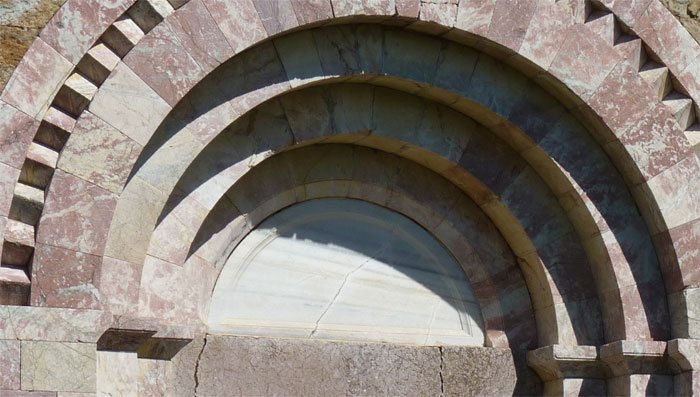The priory of Marcevol in the Languedoc-Roussillon region of France dates back to the 12th century. It is generally assumed that the bishop of Elne donated a church known as St Mary of Marcevol to the Canons of the Holy Sepulcher.  This order came into existence in the wake of the First Crusade. The early years of the Knights Templar were also linked to the same ancient church in Jerusalem which is believed to have been build directly above the tomb of Christ. Although the Canons of the Holy Sepulcher eventually also became militarized, similarly to the Knights Templar and the Knights Hospitaller, their role during the era of the Crusades was not as prominent. Perhaps as a result of this relative obscurity, the priory of Marcevol is believed by many locals to have been a Knights Templar property (the Knights were indeed prominent in this area). As such, it is featured in a legend which is quite simple on the surface, but contains a powerful and enduring message.
This order came into existence in the wake of the First Crusade. The early years of the Knights Templar were also linked to the same ancient church in Jerusalem which is believed to have been build directly above the tomb of Christ. Although the Canons of the Holy Sepulcher eventually also became militarized, similarly to the Knights Templar and the Knights Hospitaller, their role during the era of the Crusades was not as prominent. Perhaps as a result of this relative obscurity, the priory of Marcevol is believed by many locals to have been a Knights Templar property (the Knights were indeed prominent in this area). As such, it is featured in a legend which is quite simple on the surface, but contains a powerful and enduring message.
When the Knights Templar fell out of grace in the early 14th century, it was the Papal Bull called Vox in Excelso (published in 1312 at the Council of Vienne) which officially suppressed and disbanded the Order. According to local folklore, at the very moment when Clement V signed the document, a load-bearing lintel above the main door of the Priory of Marcevol cracked. Pierre Vidal who reports this local belief in his “Guide historique & pittoresque dans le Département des Pyrénées-Orientales” (1899) concedes that many churches have cracked lintels. But there may be a special reason why the Priory of Marcevol has this particular legend associated with it. The exact year when the bishop of Elne gave this property to the Canons of the Holy Sepulcher was 1129. It was also the same exact year when of the Order of Knights Templar received its official recognition from the Catholic Church at the Council of Troyes. An interesting coincidence! Whether or not the date when the lintel was broken is correct, this legend is onto something.
Myths and legends do not merely express the collective imagination of people who live in a certain area. These stories tend to pick up the most important themes that pertain to life and being. They pack universal truths into accessible symbols. Let’s look into the deeper meaning of the broken lintel at Marcevol.
There are definite Biblical references in this story. In Matthew 27 (NIV) we read:
50 And when Jesus had cried out again in a loud voice, he gave up his spirit.
51 At that moment the curtain of the temple was torn in two from top to bottom. The earth shook, the rocks split 52 and the tombs broke open. The bodies of many holy people who had died were raised to life. 53 They came out of the tombs after Jesus’ resurrection and[e] went into the holy city and appeared to many people.
54 When the centurion and those with him who were guarding Jesus saw the earthquake and all that had happened, they were terrified, and exclaimed, “Surely he was the Son of God!”
The cracked lintel in Marcevol is a sign of the Templars’ importance. Their Order was named after the Temple of Jerusalem in which Jesus had preached and in which the curtain ripped at the moment of His death, symbolically asserting that the Holy of Holies became accessible to all of mankind. The split rocks and tombs breaking open, described by the Gospel writer, highlight the connection between the church in Marcevol and the Holy Sepulcher, the site of Christ’s resurrection. The crack in the lintel of this New Covenant Temple represents a break in the Church’s commitment to Christ, manifested in the destruction of the Order whose main purpose was to provide access to the Holy Land for all Christians.
What especially affects us in stories such as these is the acausal parallelism of events. The physical (and spiritual) event of promulgating a papal bull should not cause instant damage to a faraway building. An earthquake should not raise dead saints to life with any degree of necessity. It also should not tear curtains down the middle without causing any noticeable damage to the building itself. Carl Gustav Jung, perhaps the greatest psychologist of the 20th century, used the term “synchronicity” to describe such statistically improbable parallel events. To illustrate this phenomenon, Jung used the now famous case from his own life. He was treating a patient who was “steeped in Carthesian philosophy” and there was a need to break her out of this overly rationalistic set of mind. During one of their sessions, she was telling Jung about her dream in which someone gave her a golden scarab. This dream probably could have been of some help in the framework of Jung’s standard methods of therapy relying on archetypes and symbols. Unfortunately, the patient’s disposition could render such interpretations almost fruitless. At this exact moment, Jung heard gentle tapping behind his back. He turned around and saw that an insect was knocking against the window-pane. Jung opened the window and caught the creature, as it flew in.  The insect in his hand was a scarabaeid beetle, the common rose chafer. Its Latin name Cetonia aurata refers to the beetle’s golden color. (As a matter of fact, when Carl Linnaeus first described this insect in the 10th edition of Systema Naturae, he called it Scarabaeus auratus – Golden scarab. Jung was probably unaware of this fact, since the nomenclature has changed since.) Jung handed the beetle to the patient with the words, “Here is your scarab.” This experience was crucial for the patient’s progress, as well as for C. G. Jung’s own work. According to the great psychologist, significant acausal parallelisms could be explained in the framework of Unus Mundus (One World), the ancient concept of fundamental oneness of all spiritual and material phenomena. In Unus Mundus, occurrences such as the ones discussed above are perfectly logical. If one’s presuppositions about the world are entirely materialistic or entirely spiritualistic such events appear strange and coincidental. Instead, they should be seen as evidence for the fact that “the Matrix is not perfect.”
The insect in his hand was a scarabaeid beetle, the common rose chafer. Its Latin name Cetonia aurata refers to the beetle’s golden color. (As a matter of fact, when Carl Linnaeus first described this insect in the 10th edition of Systema Naturae, he called it Scarabaeus auratus – Golden scarab. Jung was probably unaware of this fact, since the nomenclature has changed since.) Jung handed the beetle to the patient with the words, “Here is your scarab.” This experience was crucial for the patient’s progress, as well as for C. G. Jung’s own work. According to the great psychologist, significant acausal parallelisms could be explained in the framework of Unus Mundus (One World), the ancient concept of fundamental oneness of all spiritual and material phenomena. In Unus Mundus, occurrences such as the ones discussed above are perfectly logical. If one’s presuppositions about the world are entirely materialistic or entirely spiritualistic such events appear strange and coincidental. Instead, they should be seen as evidence for the fact that “the Matrix is not perfect.”
Unus Mundus is by no means homogeneous. Some events and places take precedents over other events and places. Unus Mundus has an order, a hierarchy. Few modern thinkers understood this better than René Guénon. After discussing the importance of the Knights Templar for Western Christendom, he once noted:
“These considerations make it clear on the other hand why the destruction of the Order of the Temple should have brought in its wake the rupture of regular relations between the West and the “Center of the World”; and the deviation that inevitably followed this rupture and that has become gradually more marked since then up to our own time must indeed be traced back to the fourteenth century” (Guardians of the Holy Land).
The legend about the cracked lintel at the priory of Marcevol can be very easily dismissed. We don’t have any eyewitness accounts that could be synchronized in time with the events that went on in 1312. However, the people who first resorted to the Knights Templar connection while explaining the broken lintel demonstrated impeccable intuition. The dissolution of the Order was one of the most important events in European history. As such, it deserved to have been accompanied by signs and portents.
Images by Nicosan66, Carlos Pino Andújar.
